A lean fish is a type of seafood that is high in protein and low in fat. Lean fish typically have fewer than 5 grams of fat per 3 ounces, making them an ideal choice for maintaining a healthy weight or managing cholesterol levels. Common types of lean fish include cod, tilapia, flounder, haddock, trout, pollock, and snapper. These varieties are rich in omega-3 fatty acids, which can help reduce inflammation and boost heart health. Additionally, they are packed full of essential vitamins and minerals such as zinc, iron, and B vitamins. Eating more lean fish can be a great way to get all the nutritional benefits without adding too many extra calories or unhealthy fats to your diet.
9 Types of Lean Fish
The way a fish is prepared and cooked – such as baking, broiling, grilling, or frying – can have an impact on the fat content of the final dish. When fried in oil or butter, the resulting product will contain higher levels of fat than when baked or grilled. Additionally, some methods of cooking require breading, which also adds to the fat content. It’s important to keep these factors in mind when preparing lean fish so that you can ensure it remains low-fat and healthy.
Snapper
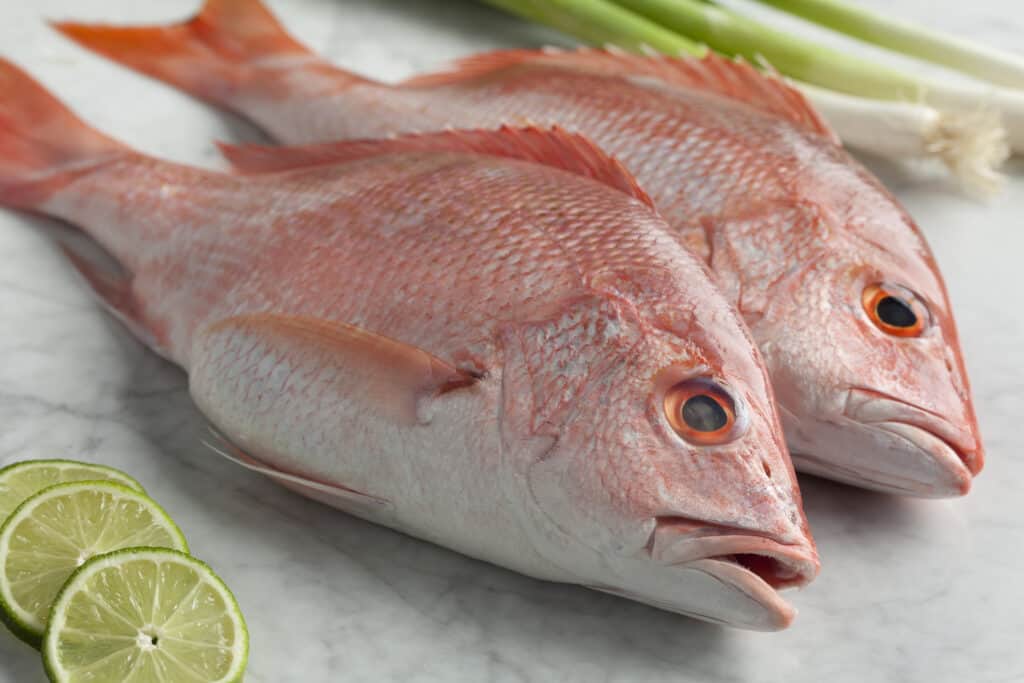
Snapper fish is a popular lean fish with a mild flavor.
©iStock.com/PicturePartners
Snapper fish is a popular, mild-flavored type of lean fish. It can be prepared in a variety of ways, including grilled, baked, steamed, and pan-fried. All types of snapper typically have white flesh that is flaky when cooked. Depending on the species and size of the snapper fish, it can contain anywhere between 1 and 2 grams of fat per 3-ounce serving (113g).
Tilapia

Tilapia can be prepared in numerous ways, including baking, grilling, steaming, and frying.
©GOLFX/Shutterstock.com
Tilapia is a lean fish that is popular in many parts of the world. It has a mild flavor, white flesh, and thin skin. Tilapia can be prepared in numerous ways, including baking, grilling, steaming, and frying. When cooked with little or no added fat, it contains an average of 1-2 grams per 3-ounce serving. It also provides key vitamins and minerals such as protein, phosphorus, B vitamins, folate, and potassium. Tilapia is an excellent choice for anyone looking to add healthy fish to their diet without sacrificing taste or quality!
Flounder

Flounder is part of the flatfish family and has a mild yet slightly sweet flavor.
©Michele Ursi/Shutterstock.com
Flounder is a type of lean fish that belongs to the flatfish family. Its texture is firm, and its flavor is mild yet slightly sweet. It can be prepared in a variety of ways, including baking, grilling, broiling, poaching, sautéing, and frying. Flounder has an average fat content of between 1.6 to 2 grams per 3-ounce serving when cooked without added oils or fats. In comparison to other types of fish, such as salmon, which contains approximately 18 grams of fat in a similar serving size, flounder is considered very low in fat.
Cod

Cod has a flaky white flesh and can be prepared in several healthy ways such as baked.
©iStock.com/Al Gonzalez
Codfish is a member of the Gadidae family, which includes haddock, pollock, and hake. It is found in cold oceans around the world and has a mild flavor with flaky white flesh. Codfish can be prepared in many different ways, including pan-frying, baking, steaming, or poaching. When cooked properly, cod has an incredibly delicate texture that pairs nicely with light sauces or herbs like dill and parsley. A typical 3-ounce serving contains approximately 1 gram of fat, making it an excellent choice for those looking to maintain a healthy diet.
Sole

Sole fish is an excellent choice for those looking to limit their fat intake.
©hlphoto/Shutterstock.com
Sole fish is a lean, white fish that typically comes from the Mediterranean and Black Seas. It’s known for its mild flavor and flaky texture, making it popular among health-conscious eaters. It is most commonly served either grilled or baked in foil with a variety of seasonings to enhance its natural taste. On average, sole contains around 1.1 grams of fat per 3 ounces of cooked fillet, making it an excellent choice for those looking to limit their fat intake. This type of fish also provides numerous nutritional benefits, such as protein and omega-3 fatty acids, which can help reduce inflammation and support heart health.
Haddock
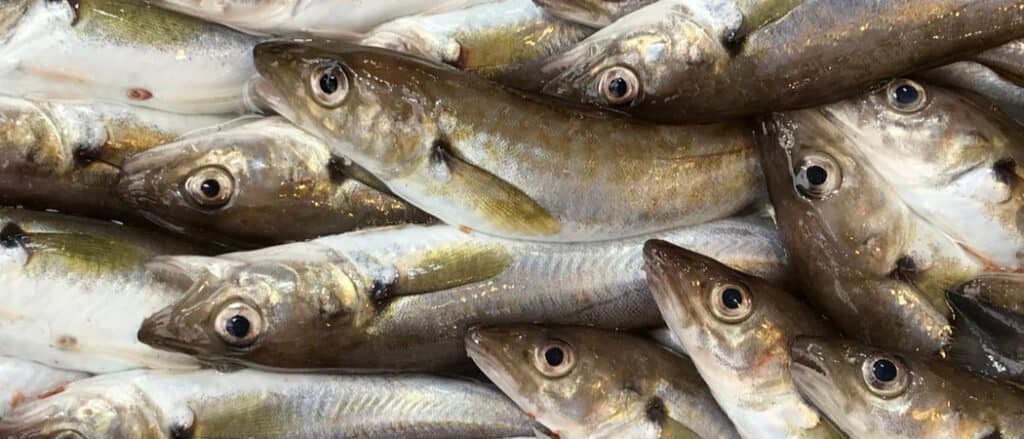
Haddock is a lean fish with a mild flavor and delicate texture.
©NORTHERN IMAGERY/Shutterstock.com
Haddock is a type of lean fish that belongs to the cod family and is found in North Atlantic waters. It has a mild flavor and delicate texture, making it an ideal choice for cooking. It can be prepared in many ways, such as baking, broiling, grilling, steaming, or poaching. Haddock also makes great additions to chowders and stews. When cooked properly, haddock is low in fat, with only 1 gram per 3-ounce serving. This makes it an excellent choice for those looking for healthier seafood options!
Pollock
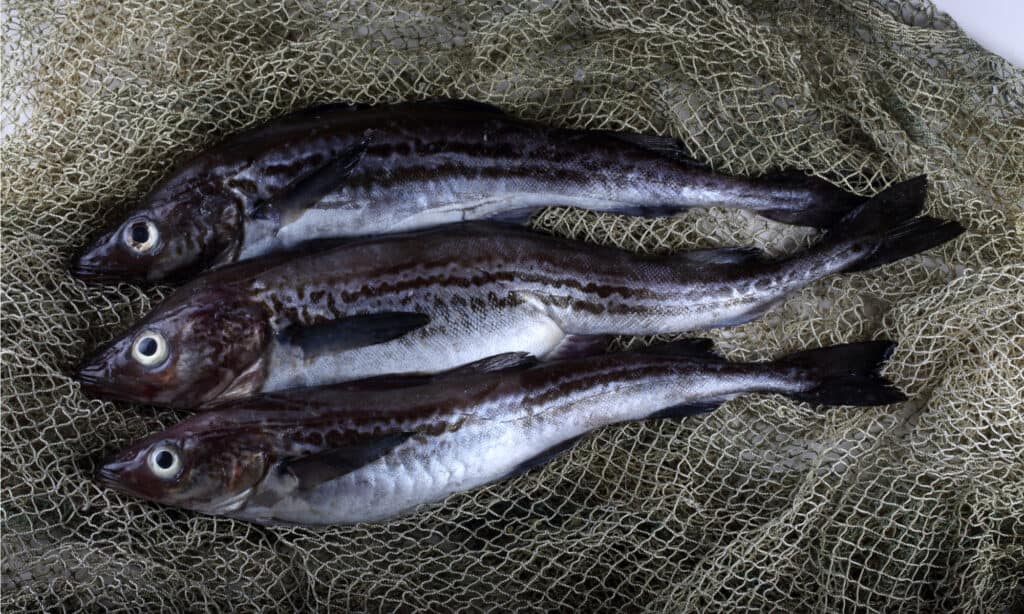
Pollock is a low fat fish that has a meaty texture when cooked.
©Alex Coan/Shutterstock.com
Pollock is a type of lean fish found in the North Pacific and North Atlantic Oceans. It has a mild, slightly sweet flavor and meaty texture when cooked. This makes it an ideal choice for many dishes, such as grilled, baked, or fried fillets, soups, and chowders. Pollock can also be used to make surimi – imitation crabmeat made from minced fish flesh – which is commonly found in sushi rolls or sandwiches.
When prepared with skin-on, pollock contains around 0.8 grams of fat per 3-ounce serving size. However, this amount may vary depending on how it’s cooked. For example, if you pan-fry your pollock with oil, then the fat content will increase significantly due to the added grease required for this method of cooking.
Trout
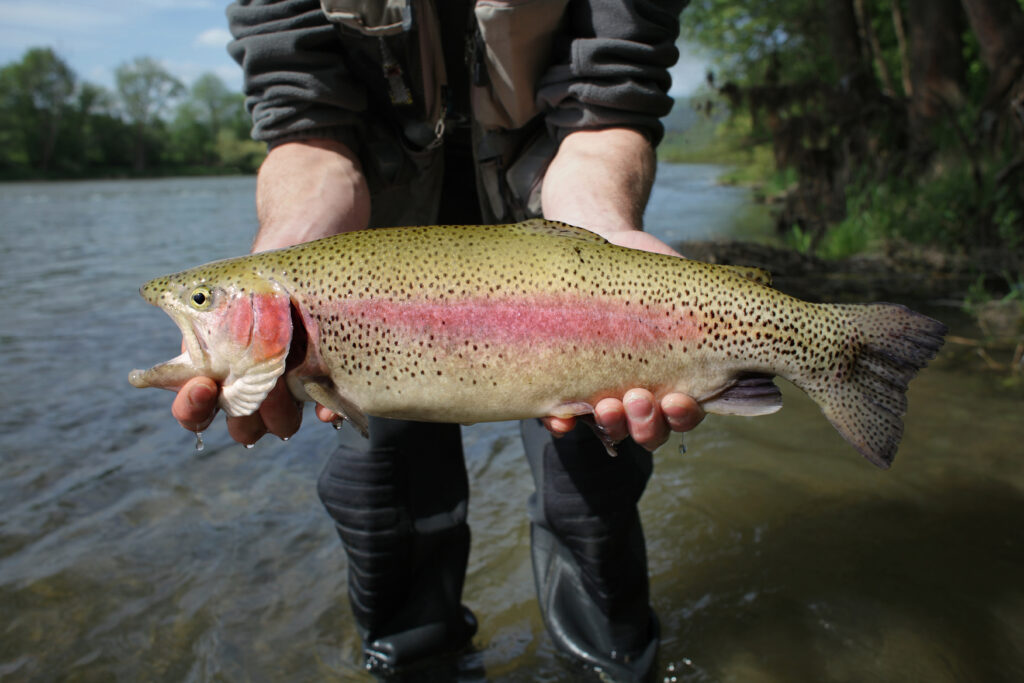
Trout is a freshwater fish often found in streams, rivers and lakes.
©pictoplay/Shutterstock.com
Trout is a freshwater fish that belongs to the Salmonidae family, which includes salmon and char. It is commonly found in streams, rivers, and lakes throughout Europe and North America. Trout has a mild flavor with delicate flesh that can be served either cooked or raw. Common methods of preparation include baking, grilling, pan-frying, or poaching.
When it comes to nutrition, trout contains an average of 5 grams of fat per 3-ounce serving size. It also provides high amounts of essential nutrients like vitamin B12 and selenium as well as omega-3 fatty acids, which are known for their heart health benefits. Furthermore, trout is low in calories, making it an ideal choice for people looking to watch their weight while still getting the nutritional benefits from this lean fish option.
Tuna
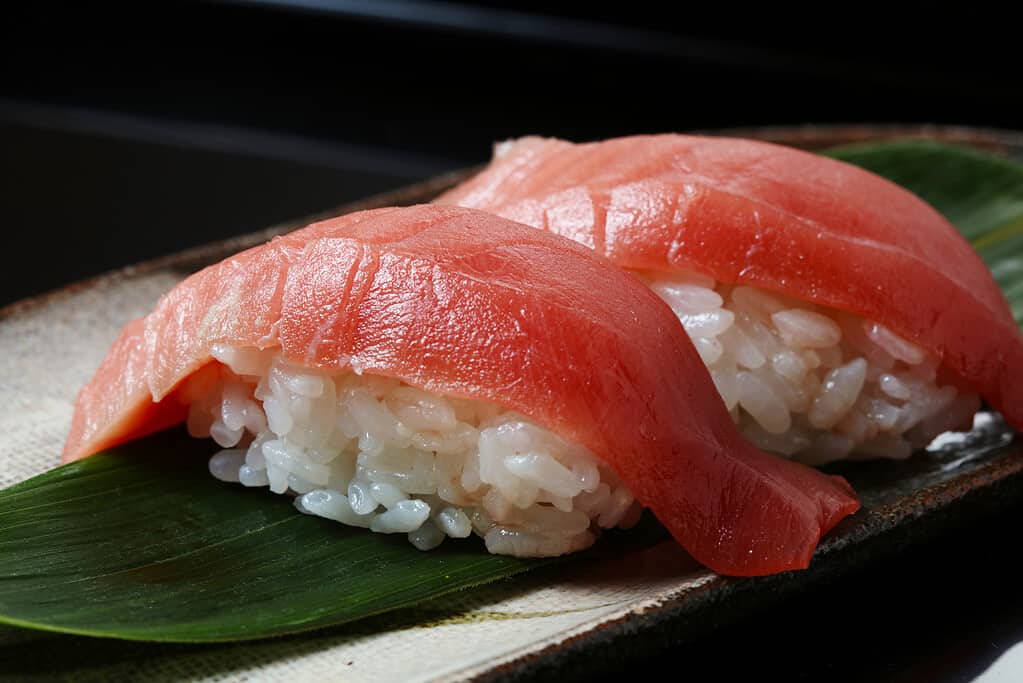
Tuna is a salt-water fish that can be prepared in many ways including raw for sushi.
©iStock.com/key05
Tuna is a type of saltwater fish that belongs to the mackerel family Scombridae. It can be found in oceans around the world, including the Mediterranean and Atlantic. Tuna is one of the most popular types of lean fish due to its mild flavor, versatility, and high nutritional value.
Tuna can be prepared in many ways, such as grilled, seared, baked, canned or raw for sushi or sashimi. When purchasing canned tuna, it is important to look at labels for sodium content as some brands contain large amounts, which could be unhealthy if consumed regularly.
Nutritionally speaking, tuna contains low levels of fat, with 3 oz (85 grams) containing 1 gram of fat and 18 percent protein by weight. Additionally, it provides essential vitamins like B12 and minerals such as magnesium and phosphorus, which are beneficial for bone health.
Where to Find Them
You can find lean fish to eat in a variety of places. Many grocery stores sell fresh, frozen, and canned varieties of lean fish such as cod, flounder, tuna, and tilapia. You can also visit your local farmers’ market for sustainably-sourced options like trout or mackerel. If you live near the coast or other bodies of water that are known to have an abundance of certain types of fish, you should consider checking out some nearby fishing spots so you can catch your own dinner! Finally, if none of these options work for you, there is also the option to purchase high-quality seafood online from trusted sources.
Summary of 9 Types of Lean Fish
| Type of Lean Fish | Grams of fat in 3 ounces |
|---|---|
| Snapper | 1 gram of fat per 3-ounce serving |
| Tilapia | 2 grams of fat per 3-ounce serving |
| Flounder | 2 grams of fat per 3-ounce serving |
| Cod | 1 gram of fat per 3-ounce serving |
| Sol | 1.1 grams of fat per 3-ounce serving |
| Haddock | 1 gram of fat per 3-ounce serving |
| Pollock | .8 grams of fat per 3-ounce serving |
| Trout | 5. grams of fat per 3-ounce serving |
| Tuna | 1 gram of fat per 3-ounce serving |
The photo featured at the top of this post is © iStock.com/Vladimir Mironov
Thank you for reading! Have some feedback for us? Contact the AZ Animals editorial team.







